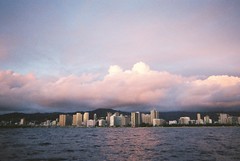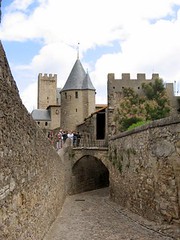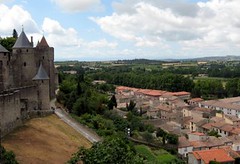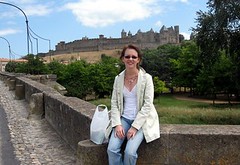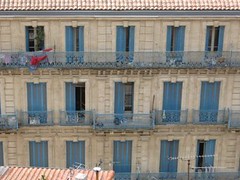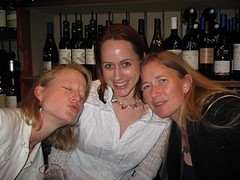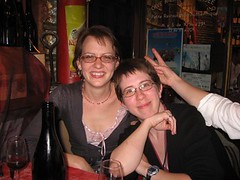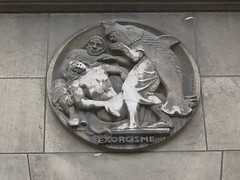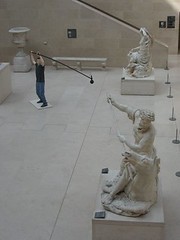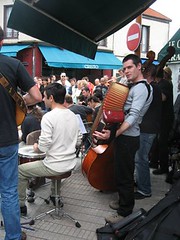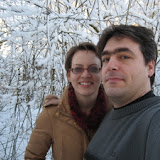 |
| Recklingha |
Monday, December 31, 2007
Photos from Christmas in Recklinghausen
Next installment of blog transfer
Ordovers
Political intrigue and funky music in our nation's capital
I’d heard both positive reviews and horror stories about the Chinatown buses I’d arranged to take from New York to Washington, so I was curious to see what would happen. What did happen was that I very nearly missed it, the damn E train was so slow in coming, and had to take a cab the last ten blocks. But then I was pleasantly surprised to find a fairly comfortable vehicle, only half full. I could take the window seat and spread out over the aisle one as well. However, the window seat did not turn out to be advantageous. A screen was pulled down to shade us from the sun, and the bar at the bottom kept hitting me in the head. This wasn’t restful at all, and after ten minutes of wrestling with the damn thing together with my neighbor two rows behind, on the other end of the bar, we determined the blind’s retractor was broken and the clip that seemed meant to hold it in place was the wrong size. On second thought, that aisle seat looked pretty comfortable.
At any rate, our journey from Chinatown to Chinatown was otherwise uneventful. Soon I found myself under the giant, elaborately carved gateway on DC’s Gallery Place, where I decended into the metro system, so much cleaner and more efficient than New York’s 100-year-old underground labyrinth, and found myself on the doorstep of Carolina, who I’d never met before but who worked for my dad some years ago. Her Argentine accent, which I could barely understand from disuse at first, brought back memories She accompanied me to the grocery store, showed me to my futon, and then got me watching Alias, her favorite show. She and her roommate Susmita promised I would get hooked, and indeed, at the end of the first episode I was anxious to see what happened on the next.
My first morning in DC did not start off quite so promisingly as the night before. I looked pretty cute in a new skirt and fancy shoes, but I soon found out I’d chosen the wrong day to break those suckers in. On the map, it looked like a simple and not-too-long walk from the Union Station metro stop to the library, so I decided I might as well get off there rather than change trains for the closer Capitol South station. A little walk in the morning could only be good.
Ha ! The “little walk” turned into half an hour of wandering around the perimeter of the Capitol building. I didn’t realize the street situation was so confusing around there. I knew I needed to walk south on First Street, and when I emerged from the station I found First right away. But when I crossed the street, I wasn’t on First anymore, and it was nowhere in sight. If I passed through the little park, surely on the other side things would become clearer, I naively thought, but when I emerged from the trees I found myself on yet another, equally incorrect street. I asked someone for directions to First Street and they confidently pointed me off to the right. I did find First over there, but it led me around the wrong side of the capitol, and so I discovered there were actually two Firsts here separated by a couple of very long blocks. After contemplating the Capitol from all angles, I eventually came around to the correct First (though now it could more appropriately be termed Last), but by this time the new, stiff leather of my shoes had produced sizeable blisters on my toes, knuckles, and heels. I tried to think of other things to keep going, but by the time I found the library, passed through security, checked in at the reading room, and went to the bathroom to clean up, my feet were a bloody mess (as were the insides of the new shoes).
I hobbled back to the American Folklife Center reading room where I met my hosts and kicked off my shoes to listen to old tapes on a reel-to-reel for what was left of the morning. By lunch I couldn’t take it anymore and limped down to the nearest CVS pharmacy where I bought two boxes of bandaids and a pair of$2 flip-flops - maybe the best two bucks I ever spent. My feet thanked me and I smiled as I headed back down capitol hill in my smart black pencil skirt and neon pink striped footwear. After a quick lunch at the Library of Congress workers’ coffee shop, hidden away in the basement of the boxy, newish Madison building at the end of a long, twisty underground passageway from the historic Jefferson building, I let the antibacterial bandages work their magic as I listened to my 1940s field recordings from the Dominican Republic.
My usual work schedule is approximately 12 - 9 PM, so I was only just hitting my stride when the reading room closed at 5. It’s a good thing I arranged to spend two weeks here, because I realized it was going to take me some time to get through all the tapes and do the transcriptions as well. At any rate, Carolina had arranged an after-work welcome party at a sushi restaurant at Dupont Circle, rumored to have some good happy hour deals. I flip-flopped over there and ordered a celebratory glass of wine. Soon the WRI (World Resources Institute) crowd showed up and we ordered big platters of sushi rolls. The favorite, by consensus, seemed to be “spicy crunchy tuna.” No one seemed to know what the crunchy part was made of (it was brown and grainy) but the $3 drinks had dimmed our faculties enough that we didn’t worry about it too much. Also, though I’d been afraid of going out with a work crowd that would then get into long boring conversations over people I didn’t know, budgets, or some other work-related matter, they were actually very well-behaved. Kudos to the WRIers for having lives outside of work !
Having consumed an appropriate amount of raw fish, wasabi, and alcohol, we prepared to descend into the metro once again. At the top of the escalators was a man, perhaps West African from his accent, with a keyboard and a microphone. As we passed by, he asked rhetorically, “Do you like funky music? Who likes that funky music?” Well, I like funky music, I thought but did not say. Perhaps I should have said, because he then launched into the least funky keyboard playing, slow and pop-ballad-ish, that I’d ever heard. His non-funky lyrics included, “When I was a kid / my mama would hit me on the chin.” I did not like that funky music.
The next day, I did much the same thing at work, only in comfy sandals. Afterwards, Carolina had planned another interesting evening for us. In commemoration of Fidel’s July 26 Movement that carried out the successful 1959 revolution, the Cuban Interests Section was throwing a party. (Since Cuba and the US do not have diplomatic relations, Cuba does not have an embassy in DC but instead an Interests Section within the Swiss Embassy. The same is true of the US in Havana.) We wangled tangential invitations out of Lucy, a health services translator for DC Latinos and a friend of Carolina’s close friend Kendra, and met up with her at a bus stop in Columbia Heights to head over to the party. On the way over, we were warned not to talk about any trips one may or may not have taken to Cuba, as informers are often present at events in the Interests Section.
And so we found ourselves entering the marble-floored lobby of the embassy, where we signed in (I wonder where the guest list will be sent next) and ascended the grand staircase, greeting the embassy officials at the entrance to a wood-floored, crystal-chandeliered ballroom. Although it was in better conditions than most buildings I’d seen in Cuba, in other ways it reminded me very much of that country. There was no A/C, so the six-foot window shutters were open to let in the hot, humid air. It cooled down only slightly as night fell and we all angled for a spot near the windows, sitting on the wrought-iron grates to try to catch an infrequent breeze. An official made a long speech, made double in length by the accompanying English translation, about how the people of Cuba and the US were united, but our president’s policies were stupid and spiteful. Although we agreed we couldn’t muster up much enthusiasm in the heat. Some of the better-prepared Cuban ladies had come prepared with Spanish fans, and I emulated them with my folded-up bus ticket, less stylish but somewhat functional. When the speech was over, we made a beeline to the free mojitos and Cuban food: congrí, pernil, salad, and yuca, with syrupy pickled guavas and hunks of creamy white cheese for dessert.
As we enjoyed our refreshments we mingled and conversed with whoever came our way: a Spanish professor, some Cuban officials, and finally a Czech called Alex. He was an old man with a long, yellowed ponytail, and he apologized for his odd method of drinking, as he’d recently had cancer removed from his lip. His long and fascinating life slowly unfolded before us. He’d worked in Chile for some time before coming to the US. His wife was German, a beautiful and strong woman, but she had died two years ago from Parkinson’s brought on by a stressful experience. He couldn’t work anymore, but his son made a lot of money as a computer executive and was able to support him. He’d gone to Chile after Pinochet ousted the pro-communism Allende “because the Russians had lost all their contacts there, and they needed someone to establish new ones.” Wait a minute, I thought. “Who were you working for, then?” “For the KGB.”
Then the whole story came out. He had begun working in some generic office job for the Russians in Czechoslovakia as a young man. Eventually he got drafted into the secret service. He worked in various areas before being sent to Chile. Although he spoke no Spanish at the time, his young son learned it quickly and translated for him. His wife was in the same line of work. He showed us her picture: with short blond hair and a sleeveless khaki shirt, she was looking off into the distance over a garden wall, seeming both courageous and prepared for anything. After their mission in Chile was accomplished they were sent to the US. Here, just a few years ago, someone betrayed them and the whole family was imprisoned. Alex made a deal and his wife and son were freed, but not before his wife had been subjected to a lengthy and hard interrogation, which led to her developing Parkinson’s far too early in life. She died two years later.
Meanwhile, Alex’s social security number was deleted and assets seized, making sure he would never work in this country again. In his career, he’d been known by seven names besides his own, and even showed us an ID card that read “Rudolf Herrman” on the back and his real name, which at lest he can finally use, on the front. “Did you ever get confused?” I wondered. He didn’t. Now, he leads a quiet life. “Everyone I used to know is gone now.” He misses his wife very much and is proud of his son. He likes to tell his stories to whoever wants to listen, but I bet there are many he won’t tell, too. After this conversation, I danced to some timba music with various Cuban officials in the ballroom, but Alex was a hard act to follow.
A Query: Does anyone out there speak Czech? If so, I’d love a translation or summary of this article I found online that appears to be about the capture of Alex and some other KGB agents: http://zpravy.idnes.cz/vedatech.asp?r=vedatech&c=A020617_120804_vedatech_jan&r2=vedatech
Alex was still on my mind the next morning as I rode the train to Capitol South (I learned my lesson about Union Station). On the train with me was a typical DC mix: suited politicians, foreign tourists with children, and a Future Farmers of America delegation, its members all heavy-set and all iin identical blue corduroy jackets with their states embroidered on the back: West Virginia, Wisconsin, Minnesota. What a country this is. I got to see even more of its diversity at lunchtime, when the AFC had scheduled a performance by a Laotian music and dance troupe from Iowa, of all places, resettled there on an Iowa State refugee program. They were fantastic and so enthusiastic about presenting their culture to North Americans, it could only be described as heart-warming. I confess that, for me, a beautiful performance always produces a very visceral reaction. When I hear an amazing pianist, I literally get chills up and down my spine, and if they’re very good, the sensation can be sustained for the whole piece. When I see an amazing dancer I get choked up and teary-eyed. I don’t know why. But for whatever reason, I had this reaction to the Laotians. I think it was their beautiful costumes, painstakingly sewn from gold-embroidered silks by an Iowa seamstress, the stately music learned from a long line of teachers who must be acknowledged with an offering before every performance, their graceful movements and expressive hands, the smiles that passed between the performers and then out to the audience. All this made me think about how much work it must have been for them to learn this art, which they had done at a state conservatory back in Laos, and how it must be an even harder job to keep it going in the US Midwest. That kind of job can only be done out of intense love. I guess that’s why I get choked up the way others do at weddings: I think of all the love and beauty that can be found in people everywhere, all the time, and this optimistic part of me tells the pessimist that, someday, this might be enough.
The euphoria seemed to continue through the night and into the next day, when I found myself bounding down the stairs to the red line metro, thinking, “Life is good ” Indeed it was. The hours of listening to the ancient field recordings paid off in the form of an interesting discovery. I found that the lyrics to a popular merengue still commonly played today actually come from an old mediatuna, a type of improvised folk poetry from a Cibao, rather than being composed in the 1970s as generally supposed. I just about fell out of my chair when I heard the familiar words coming off a 1940s field recording. I can’t wait to tell Rafaelito about it, as this is the kind of discovery that interests practicing musicians as much or more as it interests us academics.
Somehow I managed to tear myself away for long enough to go hear a noon lecture on Alan Lomax’s recordings of non-English-speaking communities in the US. These recordings aren’t as well known as those he did of African-Americans in the South, but just as interesting. Examples were presented of Finnish, Mexican, Cajun, Polish, and Amish musics, but the audience was most taken with a track recorded by a Serbian auto worker in Detroit in the 1930s. He had made himself a duduk double flute out of “metal rods discarded on the factory floor” on which to play the melodies of Serbian shepherds in the Motor City. One audience member pointed out that pipes would be more convenient for flute-building than rods, and we had to conclude that Lomax had been a bit sloppy in his notes that day. It was amusing to look at some of his other notes. A telegram to his boss back in Washington requested, “Send advance or money or something. I’m not eating.” An expense report listed “mule team” as one of the items - he’d had to hire one to pull his car out of a ditch in a town with no cars.
Viva la Revolucion!
Friday was my mom’s birthday, but since I couldn’t be with her, I celebrated with a meeting at Folkways Records, instead. Director Dan Sheehy met me and showed me their new Latino musics series, which of late has featured styles like Colombian gaita, Mexican arpa grande from Michoacan, and Argentine nueva cancion. This is good, but clearly merengue tipico is needed to make the collection complete. Luckily, Dan agrees, and we worked out a plan to make a Folkways tipico release a reality - assuming their grant money comes through in the fall. Stay tuned
While there, I got the deluxe tour of the Folkways offices. Among the stops on the tour were the recording/mixing lab, where workers were busy duplicating making a CD copy of an ex-LP of testimony given by Bertolt Brecht at some hearing or another; the archives, where I admired a Mo-bile made of photocopied pictures of Mo Asch hanging by strings from artfully assembled toothpicks; the wall of fame, where copies of Folkways recordings line the walls; and finally the secret storage closet, from whence Dan extracted an attractive “Listen Up” t-shirt for me.
The fun continued after work, as the WRI crowd was convening for a margarita cocktail hour at the house of one of their rank, also celebrating her birthday. So we stopped to pick up margarita fixings, chips and salsa, crackers and cheese, which only took about an hour after all the deliberations required. At that point I was starving and looking forward to eating the spoils right away, but it was not to be. Little did I know how far things can actually be from subway stations in DC. From our liquor store stopoff, it was about another hour of walking before we actually arrived at our destination.. I may be exaggerating, or then, I may not be. But once we arrived we wolfed and/or slurped down the snacks and/or alcoholic beverages pretty quick. We were aided in this by a drinking game, which someone had though a good idea and therefore looked up some inordinately complicated rules on the internet to help us along. This game worked on the premise of combining aspects of every other game known to man into one unwieldy whole, and involved drawing cards and then asking questions, doing a truth or dare, inventing rules, or coming up with names for genitals. After we reached the “Washington Monument” moment, we figured things just couldn’t go any further than that, and decided to call it a ten-way tie. After that, some were hoping for more substantial food, but that also was not to be. The rest of the night was spent at corny college bars along 18th street in Adams Morgan, the most drunken few blocks I’d seen in a long time. Suffice it to say that at the first bar we went, the decor consisted of neon beer signs on the walls, farm implements hung from the ceiling, and plaques of clever sayings hung behind the bar, while the fun consisted of watching for a skeleton-shaped robot wearing a tuxedo to swivel his hips, at which point one could receive a jello shot for only $1. The price still wasn’t low enough to convince me to drink one. Suffice it also to say that the next stop on our tour was called “The Tom Tom Room” and our neighbors there were a group of five blond girls in matching black dresses and high heels, one extremely pregnant, posing for pictures while draped across chairs and small step ladders. Maybe we should have stuck with those jello shots after all.
There was only one way to recover from that evening on Saturday. I was in Our Nation’s Capital: I had to see Our Nation’s Baby Panda Bear. I’d been following the young guy’s life via webcam since last year (haven’t you?). It was a nasty, hot, sweaty day, and all the animals, being much smarter than us humans, were sleeping indoors. After waiting and sweating 20 minutes in line, that’s where I found him, yawning and stretching. He was as adorable as you would think. After that, I couldn’t find the giant anteater so I visited the elephants and giraffes instead, then the invertibrates, the primates, and last but not least the new Amazonia exhibit. I recommend it: you start out underwater so you can check out the piranhas and other weird jungle fish, then go up into the forest part which is in a big greenhouse with free-ranging monkeys and parrots. Outside, there were more free -ranging monkeys, and as I wandered around in my usual oblivious state I just about ran into five golden lion tamarins right next to the path.
I knew I wouldn’t have much time for sightseeing this trip, but the panda was the only sight I really just HAD to see, so I felt glad I’d accomplished my mission. That evening, my second wish came true as Carolina and her friend Kendra accompanied me to eat tasty Ethiopian food back in Adams Morgan again (much safer and less drunken during the daylight hours). Washington DC has an astounding 2-300,000 Ethiopians living there, which has led to the establishment of numerous excellent Ethiopian restaurants. The oldest ones date back to the 1970s and are in Adams Morgan around 18th and Columbia; there is a new enclave around 9th and U that I haven’t checked out yet. We decided on an old favorite, Meskerem, and were not disappointed with the spicy sambussa, foamy injera, and flavorful vegetable stews.
When we finished, it was still too early for any nightlife, which technically should begin after dark, so we grabbed a table in front of the Latin music spot across the way, Bossa. We were there a looooong time with our Negra Modelos before anything started happening, but eventually people started arriving and we decided we’d better claim an inside table before it was too late. Bossa has two floors with two different bands. Both were good, but the upstairs was way too crowded. I went up briefly to hear some rock en espanol but quickly returned downstairs where the real dancing was going on. Well, I say “real,” but most people didn’t seem to have much clue of what was going on; they were probably only out there as a result of the beverages they’d been consuming in previous hours. I did have one good partner, a Peruvian who threw me around so effectively in the stifflingly hot dance floor that at one point my nice new glasses slid right off my sweaty nose, throwing me into a momentary panic as I blindly groped the floor amidst the dangerous assortment of footwear whirling around me. Luckily, the peruano found them. Now I remembered: not only had I not really danced since the second knee surgery, I hadn’t really danced since a nasty eye infection forced me to switch from contacts to glasses. Oops.
Still, we had fun. The band playing at the downstairs dance floor was composed of only four men, on keyboards, bass, timbales, and congas, who played mostly classic Cuban tunes. One was Cuban, one Salvadoran, and the other two looked like they might be Mexican or other Central Americans. Later another Cuban joined them as vocalist, and we chatted with both him and the Salvadoran jazz pianist. The Cuban singer had been in the US only a short time, having come to Washington to work and live with family nearby in Adams Morgan. Carolina was whipped into a revolutionary fervor through some combination of her recent trip to the island, our repeated Cuban encounters throughout the week, and the five or six Negra Modelos she’d consumed, so when our friend returned to the stage, she ran over to ask him to shout “Viva la revolucion!” Just so that we could all shout “Viva!” in return, as if at a Castro-led rally. He was in the middle of “La Guantanamera” at the time, and he went into an extended soneo, or section of improvised lyrics. He turned his back to the audience, as if to gather his thoughts, and we heard him say, “Si, que viva...” and just as Carolina got all excited he followed up with “...que viva la Guantanamera!” We collapsed into laughter.
At about 2:30 the show was finally over and I was more than ready to head to bed, but Carolina was not. Apparently, she was waiting for (a) her opportunity to talk more with a cute Colombian waiter and (b) her friend’s opportunity to talk to the attractive bar owner. There was nothing in this deal for me, so I just got sleepier and sleepier after a record 7 hours in the joint, but when at last I convinced them of the folly of their plotting we found there were no cabs to be had in the madhouse that the street had become as all the bars ejected their drunken patrons. After my years in New York and the DR, neither of which have “closing time” in their vocabulary, such an eventuality had never crossed my mind. We took a long walk, argued a cab driver into making two stops he didn’t want to make, and eventually made it home an hour later. Phew. That’ll teach us to stay in Adams Morgan past 3.
Needless to say, Sunday was not a day of action. Monday was not eventful either, although I did make another interesting discovery in the archive: a song familiar to all tipico enthusiasts today, recorded in 1944 with different lyrics. My teacher, Rafaelito, had in fact told me that prior to Tatico the song had different words, and had recited a verse to me in almost exactly the form I found it on this old tape. But this one had a second verse, too. Can’t wait to tell him.
The next day I ventured over to the Recorded Sound Collection: I’d made an appointment to hear some old Victor 78s of Dominican music. I thought over in Performing Arts the librarians might be more amusing. Not so. They were the unsmilingest group ever and didn’t respond at all to my habitual joking. Thus, I had no one to share my mirth with when I got back my book request slip stamped with the date “July 32 2006.” Apparently we were in some new kind of leap year. (Hey, I could use the extra day.) That’s OK, though, because later I did find people to laugh with me. After finishing up the afternoon in the Folklife Center, one of the far more amusing Folklife librarians invited me to join a couple of them for dinner: they were taking a visiting archivist, in town for the Society of American Archivists conference, out for the evening. “He has a really great web page about field recording equipment. You should check it out,” Jennifer told me. “Cool. Where’s the page?” “On the Vermont Folklife Center site.” “Oh, OK. Wait a minute... what’s this person’s name?” Sure enough, it could only be the one, the only Andy Kolovos, a former IU classmate of mine.
So we four folklore types, plus one friend, headed out to Silver Spring, Maryland to try a new Colombian restaurant. Actually, it turned out to be a Colombian/Dominican/Mexican restaurant that had just move into what was formerly a Japanese restaurant and even more formerly a Korean one. It was next to a Colombian bakery advertising Fruit Cakes in its window. We hoped Colombian fruit cakes were different from the American variety. Anyway, in the restaurant that still featured some of its Japanese-style woodwork we discussed Andy’s tenure as archivist at a paranormal research institute and ordered a variety of dishes: tasty arepas full of cheese, mangu or mashed plantains, fish, pigeon peas, and the infamous chicharron harmonica (later rechristened the Hamonica). This foot-long slab of salted pork curled around and split into tooth-shaped sections that reminded us of the working end of a harmonica. We couldn’t seem to get much sound out of it, though. Afterwards we were too full and too salted to deal with the fruitcakes, so we skipped them in favor of the two-bit tour of Silver Spring. Actually, we only saw one sight, but it was a big one. Silver Spring is mainly known as the home of the Discovery Channel, and since they were in the midst of their Shark Week, they had decorated with an impressive ten-story-tall shark that appeared to be embedded in their building: a tail coming out the back, fins from the sides, and an enormous toothy head facing the subway station, all about twenty stories above the ground. I wondered if it might be one of those spongy toy figures that grow in water, gone drastically awry, but apparently it was actually inflatable. The only other sight worth noting was an Indian restaurant with a tragic name: “Bombay Gaylord.” (Andy thought Bangkok Gaylord might be even better, but I don’t think Thai restaurants have gone that far yet.)
Salsa Nite, pt.2
Smokljana (It's a Serbo-Croatian thing)
The Washington fun continued on Wednesday, though no salted pork or fruitcakes were involved. Instead, I met Steve, a friend of my sister’s, and a gaggle of female friends for a nighttime voyage on the Chesapeake in his 39-foot sailboat. Once we’d purchased the beer and snacks essential to our cruising plans, we made our way to Annapolis, where our seagoing vessel awaited us at a dock reachable only through a gated community. (A gated community of pirates, I was hoping, but it was far too tidy.) We set sail in plenty of time to enjoy sunset over Maryland from the water, to the accompaniment of BB King and Sam Adams. But soon we decided in favor of silent running, the better to enjoy the night sky. The crew (them) and the onlooking loafers (me) discussed internet dating (theirs, not mine - two of them had independently dated the same sailboat owner from the same site) and the difficulties of finding potential partners who love sailing. This surprised me: who wouldn’t like sailing, I wondered - they’d have to be nuts! Of course, I hadn’t taken seasickness into consideration. Luckily none on board suffered from this so we were able to enjoy ourselves on the water until 11:30 at night - past our weekday bedtimes, but well worth the sacrifice of sleep.
The most memorable moments were passing by freighters and container ships that came upon us unexpectedly and quickly, suddenly looming over us and blocking out all the stars with their huge, black forms. A pilot boat, tiny in comparison, buzzed around the base of one Fearless Captain Steve got on the radio and made contact with their captains (one of them a woman) in order to check their courses and keep out of their way. We did indeed make it back to port safely, even with me at the wheel. Following captain’s orders I took the helm, my only directions being “stay between the red and the green lights.” When the lights were far away on the coastline and we still at sea this was easy, but they came upon us as rapidly as had the ships and soon I saw they were rather large posts with lights and, in some cases, birdnests affixed to the tops ten feet above the water. It would definitely not be good to run into these. “Don’t run into those,” was the crew’s helpful instruction at this point. Luckily, as the strait narrowed and we found ourselves surrounded with boats packed in like sardines, but all sensibly tied up for the night long before, someone more knowledgeable took the wheel and saved us all from certain disaster, and me from certain embarassment.
The rest of the week continued as it had started, me transcribing tapes during the day and attending the occasional lecture (the next one on fieldwork in Jamaica and Afghanistan). I couldn’t believe how quickly the time had passed when all of a sudden I found myself in Friday, my last day in Washington. I celebrated with a lunch with Carolina and her boss at WRI, a friend of my dad’s. “Dan’s cool, you should meet him,” my dad had said. “Dan is so cool,” Carolina’s coworkers had confirmed at happy hour last week. With that many coolness reviews, I certainly had to meet Dan. They were right: he was cool.
After that, I realized I’d spent two weeks in the Library of Congress and still hadn’t seen the main reading room, which also had many major coolness reviews. So I went up to see. Again, they hadn’t lied. It was definitely worth seeing the towering marble columns topped with bronze statues with viewing galleries in between that looked like the choir loft for a Gothic cathedral, and the soaring dome filled with stained glass several stories above. Down on the floor, dark wooden desks and chairs were arranged in a circle around the reference desk in the center, and around the perimeter were arrayed the open stacks of reference books n two tiers. Never one to resist narrow, twisty staircases, I went up and circled the room a half-storey up instead. This certainly must be one of the top ten most attractive places to do library research (the NYPL main reading room is up there too). Now why, I wondered, do they always have to hide the performing arts books around in some flourescently-lit, windowless room with no personality? Did I pick the wrong field?? No, I didn’t, I was reminded once again by some folklore colleagues at the happy hour we attended at an Irish bar after work. Who else, after all, is likely to discuss their personal experience in combining breakdance and clogging over a hearty ale?
For the grand finale to my Washington week I wanted to take Carolina out to dinner, but she was sick. It turned out to be tonsilitis, of all things. I told my dad and he said, “Tonsilitis?? But you’re supposed to get that in the winter!” “Well, I guess she screwed up,” I responded. The result of this was that we stayed in, ordered out and watched a movie. So my trip went out less with a bang than with a pad thai.
Since I’ve been back in New York, it’s been pretty much what you’d expect, only transfered to my relatives’ Upper West Side apartment rather than my former Greenpoint flophouse digs. Have I been able to interview those elusive musicians? No. Have I gotten other things done? Yes, but mostly boring errands and shopping not worth writing about here. I have had just one fieldwork success. This was in meeting with a major tipico fan at the bodega he owns, just on the border of Bed-Stuy with Bushwick. Fermin is the kind of guy who commissions homenajes, songs of homage: you might remember I met him at a tipico gig about a month ago, recognizing his name from a song Maria Diaz recorded in his honor. When I arrived, I found him behind the counter of his corner store, surrounded by an array of candies, cigarettes, and calling cards. Customers came and went with their purchases: chips, soda, toothpaste, deoderant. He told me to come behind the counter, so I ducked under the plexiglass. Fermin offered me a chair in the corner next to the shampoo and the trash can and sent his assistant, a man who’d grown up down the street from him in San Jose de las Matas and arrived in New York just a month earlier, to get me a cold Presidente. He opened it on the counter’s edge, then decided it wasn’t cold enough and put it in the freezer again.
It was a challenge to do the interview there as Fermin worked and chatted with customers, and I only got a few of the questions done that I’d planned on asking him. However, in all other ways, the four hours I spent in this Bed-Stuy bodega were quite educational and entertaining. I listened as Fermin’s accountant went over a report from a health inspector, explaining the fines he’d have to pay: one for keeping items of a chemical nature on a shelf adjacent to items of a food nature; one for having a cat in the shop. “But if I didn’t have the cat, the place would be full of mice!” he objected. The accountant further explained that if he had an employee, he’d be obligated to pay him $12 an hour and give him two weeks’ vacation as well as health insurance. At this, both Fermin and his helper laughed: they knew no Dominican bodega employee anywhere in the city was earning this lofty sum, and none ever expected to, either. The bodega owners could never afford it, and the employees (whose English is generally nonexistent, and their education at a similar level) could never find a better job. “If you’re going to keep that cat here working for you, you’ll have to give her vacation time too. She might want to go to Florida for a couple of weeks,” I suggested.
A bit later, I exited the counter area in order to search for snacks to eat, and one of the guys in the store, those types that hang about hoping for a job to do, asked if I could help another guy in the store make a phone call. “I don’t speak enough English to know what he’s saying,” he explained. The other guy handed me his cell phone. “I need to talk to this guy Francisco, but I don’t speak any Spanish,” he told me. “No problem,” I said. “What do you want me to say?” “Well, his wife will answer, then ask for him. Tell him to be at Gates Avenue tomorrow morning.” “What time?” I wondered. “Oh, he’ll know.” “Who should I say is calling?” “Oh, he’ll know. But you can say Kevin if you want.” This all sounded fishy, but whatever. The wife answered, I told her I was calling on behalf of Kevin as a translator and relayed the message. “Where? At his house?” she asked, and I asked Kevin. “No, he knows where. Gates and Nostrand.” I translated this. “Oh yes, I know what this is about,” she confirmed. “Thanks, I’ll tell Francisco.” I hung up wondering just what kind of transaction I’d just set up. Was I a good Samaritan? Or a BAD Samaritan?
Back behind the counter, I realized that the radio station playing was actually a Santiago station, La Super Regional, and that we were listening to it thanks to a computer with Internet Fermin had set up behind the counter expressly for this purpose. I commented on this, and told him I’d been interviewed twice on just that station. “Really? That’s great! Let’s call them up and say hi!” So we did. The DJ on duty was one I hadn’t met before, but he knew who I was, and asked where I was and what I was up to. “I’m hanging out with Fermin in the most tipico bodega in all of Brooklyn!” I informed him, and he agreed the definition was correct. “But I’ll be back in Santiago in January. I hope you’ll be waiting for me,” I said. He said they would be “planning something big” to celebrate my return.
With all this excitement, needless to say, the interview didn’t go far. But I did get a couple of nice pictures of Fermin at work, and Fermin’s ring, which I liked. Other excitement of the week consisted of a Burmese food and Irish music night with friends from the Washington Square Harp & Shamrock Orchestra (“The Finest Irish Band Withing A 5-Block Radius of Washington Square”), which I played with in pre-DR times. When Ben and Amelia arrived, they were accompanied by a woman unknown to us, who Amelia introduced as “Someone I found in my building.” I thought she was kidding, but when I asked the person in question (actually named Anna) she confirmed that they’d met in an elevator this morning. She turned out to be from Serbia, but had lived in California for a year, where she worked as an au pair. She also confessed to having been annoyed when she first arrived in this country and discovered that Americans didn’t actually know where her country is. So boy was she surprised when we pulled out the two words we collectively knew in Serbo-Croatian (now artificially divided into Serbian and Croatian for political rather than linguistic reasons). For some reason, Scott knew how to say “appendix.” I knew how to say “nerd.” Best not to ask why.
Red hook
Red hooks in Red Hook
Red Hook, Brooklyn
Friday, November 16, 2007
Rice, Waikiki, and dead people - notes from last fall
The following are some photos of my trip to
Here are some other notes about last fall, originally published on the other blog last November.
I’m posting a couple of pictures I took on my
I had another picturesque and totally
Gas station
Tuesday, November 13, 2007
Blog in transition
Where have I been, you might ask? I used to post once a week, nearly without fail, and now it's been four months since I've posted at all. Life is a crazy thing. I met the man of my dreams in Europe this summer so I've been a bit occupied with that (hence the forthcoming trip to Germany). Also, I got hired to teach a lecture course on Mexican music here at the University of Arizona about 2 weeks before the semester started in August. Since then I have been madly writing lecture notes, preparing power points, searching for musical examples and videos, and grading papers, so I have not had much time for anything else (except drinking - now a necessity). Just kidding - sort of. Anyway, stay tuned for further developments and travels.
What follows is the still-incomplete account of my travels in France and Austria this summer.
I'll be transferring previous trips over here as time permits. Thanks for your patience!
The Better Late Than Never Post
Today is July 4, but it’s not exactly picnic and barbeque weather where I am. Today Vienna is cold, rainy, and strangely quiet for such a big city. Thus it is a perfect day to write about what I’ve been up to for the last week or so.
Last Thursday, after climbing up the St Nazaire cathedral steps at Beziers and enjoying the dizzying view (later to be paid for with sore thighs), my friend Cathy picked me up and whisked me away to the countryside north of the city in the Herault department. This area combined with the rest of the Languedoc region is the biggest wine-producing region in France, a fact which became very obvious as we drove through rocky hills covered with vineyards. Every few minutes we passed another vigneron offering tastings of their wines and other local products like olives, tapenades, flavor-infused olive oils and vinegars. The area was very green, but more of an olive or sage green – one completely unlike the near iridescent emerald greens of the tropics, and one that reminded me of some of the hilly parts of Arizona.
It didn’t take long for us to reach our destination, Herepian – a village of about 500 located at a crossroads. Its two main streets, one leading to the larger town of Bedarieux and the other to the more picturesque medieval hamlet of Villemagne les Argentiers, meet at a little roundabout by the “new” town square. The spot is marked by a crooked “H” about five feet tall, which is lit up with white fairy lights at night. In Tucson we have “A” Mountain, in Herepian they have the H traffic circle.
Herepian is known mostly – or wants to be known mostly – for its bell foundry, said to produce bells of the clearest tones. There is a museum about it and one can see the foundry in action. At least, that’s what they say – we never did figure out when it was open. Besides that, it is also home to one of the best restaurants in the area, bringing in residents and tourists from all surrounding villages. Its old town square is quite charming, surrounded by four-story homes with rows of window boxes and a small church of an age that is indeterminate but certainly far older than anything one can see in the US. There is a small fountain on the square and another on the main road near the other restaurant, Sergio’s Pizzeria. There are two bakeries, a tobacco shop, a tiny grocery, and a bar called Le Chantier that seems far too large for the five drunks usually in residence. That about covers its amenities.
For about four years now Cathy has been the occasionally proud owner of an 18th century house in the middle of this village, down a side street barely wide enough for one car just a block from the old town square. Because she is only in residence for a short while each year, however, during the rest of the year the spiders take control, and our first task upon our arrival was to de-cobweb and sweep. Surprised, they scurried off to hide in the yet-to-be-renovated basement and attic. Then we aired things out and discovered a leak in the terracotta-tiled roof, which meant we’d have to get in touch with the handyman named Pierre.
It was by then late in the afternoon, and after doing our grocery shopping at Lidl, the Euro Trader Joe’s, it was time for wine and cheese (there was still wine in the cellar, and we bought manchego, some kind of blue, and some kind of Corsican white at the store). For dinner, we went into “town,” Bedarieux, which has an impressive selection of restaurants to choose from: Chinese, pizza, kebab, crepe, pizza, or McDonald’s. We chose a pizza place that was full of French people, which seemed like a good sign, although it also meant that it was full of smoke. It was also full of carved wooden cat models apparently collected by the owner, an aged crazy cat lady with hair dyed too dark a black, which ranged all the way around the place on several shelves. Behind the counter were photos of cats she had known (and one dog). The pizza was good, though, and the chef was from Martinique. He brought us a special homemade chili oil to spice things up.
On day 2 we had to figure out something to do with all that wine and cheese, so we decided to take it on a picnic. Following the Orb river through the hills we made our way to Roquebrun, a village built up the side of one hill. Rafting and canoe trips start here, and we watched some adventure travelers getting suited up from our picnic spot on the pebbly river beach. It was a hot day but pleasant in the shade, though some pinkish looking Brits were instead spending their time baking in the sun. From there we continued our driving tour towards St-Chinian, a region with a wide assortment of nice red wines. A store on the town square functions as a clearing house for all of them, so we stopped in for a tasting. Some are still made by monks! There were even a couple of good whites although the area isn’t known for them. I bought a bottle and would have bought a lot more if I’d had any room in my suitcase.
Back on the road, as we passed through the town of Fontcaude we noticed a sign for a medieval abbey and thought we might as well take a look since we were there. IT ended up being more of a detour than one might have thought, becoming rather comical as we made turn after turn following one sign after another and never seeming to get any closer. Eventually, however, we pulled into a parking lot on a meadow, walked into another tiny village with a tiny square where the town gossips sat around with a little dog who ran up and yapped at us. The abbey itself had been mostly destroyed at the time of the Revolution, but archeologists had turned up a few bits of ancient sculpture, an old bell foundry, coins of various types dating back to Roman times, and an oil mill, and had rebuilt a few walls – not spectacular, but an interesting bit of local history. Apparently there is also a menhir standing in a field out there which one can walk to, but it was hot and we didn’t. We did, however, pull over at the town of Olargues, which, signs told us, was one of the most beautiful in France. It was pretty darn scenic, built from garden plots along the River Jaur upwards to the bell tower that once was part of an 11th-century fortress.
Then it was time to hurry back, for we had reservations at the town restaurant and needed to change for the occasion. It was not cheap but incredibly good and lasted 3 hours or so, in good French style, with an appetizer, main dish (salmon), cheese course, and desert, all accompanied by local wine. And though we were a little overloaded afterwards we were still up for a night on the town. Normally a night on the town would consist of drinking with the drunkards at Le Chantier, but there were bigger things afoot that Friday.
All through the summer, each village puts on a party in its main square for one weekend. Bands are hired, carnival-type games put out, and a bar set up. Teenagers and young families for miles around come in to take advantage of the rare opportunity to have a nightlife – as do your stray tourists, although we seemed to be the only representatives of that group on that night.
The road into the village itself was closed off for the evening, so we left our car near the bridge over the river and walked from there. An ungodly racket was emanating from the water, which turned out to be hundreds of frogs in chorus. And as we passed through the arched and crumbling brick gate or Barbacane, past a urinating man, and into the village proper, a different kind of racket was going on. A racket that sounded strangely like… The Pointer Sisters.
As it turns out, today’s French villager’s favorite type of music is US Top 40 hits of the ‘80s. Later they also did Madonna and Michael Jackson, which was the funniest because the beefy male singer had only moments before been singing in a Barry White deep voice, making the falsetto quite the surprise. On the bright side, they were very good at what they did – the guitarist, bassist, drummer, and synth player all had chops, the singers knew their stuff, and they replicated the recordings nearly exactly. On the minus side, they replicated the recordings nearly exactly. The focus was mostly on fashion, it seemed, as the two female singers and two dancers changed clothes nearly every number from one skimpy 80s outfit to another. Tres amusant.
[I wrote this much a month ago and have had time neither to finish the entry nor to post it. Life has taken some interesting turns. Will try to finish one day soon…]
J'aime le fromage!
And now for something completely different!
It’s not the usual topic of my blog, but now I’m in France, so I guess I might as well write about it.
Here are some things I have learned.
(1) “Quark” is a type of cheese, besides being a subatomic particle.
(2) Spinach makes one say “beurk.”
(3) Paris subway doors are specially designed to foil foreigners’ attempts at getting on or off. (I figured them out, but I’d bet that in a couple of years they’ll have come up with an even more diabolical design.)
(4) You must kiss everyone on both cheeks – one bisou is just not enough.
(5) Parisians are actually friendly if you try to speak French to them and play by their rules.
(6) The Paris subway shuts down at 1 AM, and after that, good luck getting a cab, you schmuck!
(7) Southern French accents are specially designed to foil foreigners’ attempts at understanding the French language.
(8) The French disapprove of all English vocabulary except for the following: “week-end,” “OK,” and “cybercafé.” Oh, and also “techno” and “gay.”
(9) French cows say “meuh.”
Paris is crazy, but who doesn’t love it? My French is pretty crappy but everyone has been so nice and so supportive of my linguistic attempts that I can now both accomplish my daily business and pick up on French men without fear. And thank goodness, because on the day I arrived I have no idea what I did or said to anyone. I had taken a variety of sleep-inducing drugs on the plane but still not managed to actually sleep more than a couple of hours, so when I got to Charles de Gaulle I was in a stoned stupor. I have only the vaguest memories of getting my passport stamped and finding my bag, so vague that later I wondered whether I actually had done those things. Yet somehow I got on the right train, lugged my bags up the stairs in the elevatorless station with the help of a kind Frenchwoman, hailed a taxi, and made it to the apartment of the Weisz family, with whom I’d be staying.
On the way, in spite of my state, I managed to have my first 100% French conversation with the taxi driver. In an interesting coincidence, he turned out to be Haitian, so we discussed Haiti, the DR, and various dance styles, and I also quizzed him on places to go dancing in Paris. He liked merengue típico, too.
By the time I got to the apartment I had sobered up a bit, fortunately. I conversed in mediocre fashion with Claude and then decided that the best remedy for jet lag was to keep moving, so made for the Champs-Elysees where I snapped some photos with my official Arizona mascot (see exhibit A), then passed through the famous Tuileries gardens on my way to the Louvre. There, attempting to see something new, I visited Pre-Classic Greece, Islam, and Medieval France but was sorry to see Mesopotamia and Etrusca were closed. It doesn’t seem kind to shut down entire civilizations, but that’s how they are. One highlight was a temporary exhibit called “Conversations” or some such thing where modern artists had been invited to create works to be displayed alongside the medieval ones. Their interesting responses included a crowd of white plaster statues wearing clocks over their faces, dozens of scythes hanging above an ancient and spooky tomb, and a recumbent engraved marble column that looked as if it had been accidentally toppled from a pedestal and broken in two, eliciting startled responses from many innocent museum-goers.
I was relieved when finally I could crawl into bed and sleep 12 hours, preparing me for a hard day of shopping on Wednesday. The Weiszes sent me to Printemps, promising me a fruitful shopping experience. Although I was skeptical, since it was a department store and I detest shopping at department stores in the US, where I’m never able to tolerate more than about 20 minutes, I decided to give it a try. I was pleasantly surprised: in this version of a department store, the departments were not simply “men’s,” “women’s,” and “juniors,” but small individual shops organized by designer in an open layout. Because they only had a few of each item out to look at, I wasn’t overwhelmed and didn’t have to run away, and I actually made several purchases! Shopping in Paris is good. Also, on the sidewalk outside I saw a street organist winding his pint-sized pipe organ. Not an accordion, but close.
I still wanted to check out the Marais and its boutiques, however. This historic Jewish area has streets that are pleasant for walking and is also famous for its falafel, so of course I made a stop at Falafel King. I was all shopped out, both mentally and monetarily, however, so I had to content myself with just looking through shop windows. I also didn’t have too much time as I had to return home, change, and get to the conference opening reception at 7. But then I made a move that for me appears to be becoming something of a tradition on arriving in a new country – I accidentally slashed my finger open and had to lie around on my bed with my finger in the air applying pressure until the bleeding stopped. I couldn’t help having a feeling of déjà vu as I remembered the night I arrived in Santiago back in January.
Needless to say I arrived late at the Centre National de la Danse. It was a longish and crowded train ride, but better late than never. The CND is actually in a suburb, Pantin, which is sort of an odd area to hang out in – a mix of old and new buildings with mostly empty streets and few restaurants, populated largely by North African immigrants. At any rate, the reason the trains were crowded, it turned out, was that for that day and that day only it was the city-wide Fete de la Musique. The Music Fest comes but once a year, and when it does, bars and restaurants all over the city have live music and everyone can ride on the subways and trains for one low price, no limits. I had forgotten this fact when I went to dinner with friends at a nearby Algerian restaurant, where we had tasty couscous and my first Algerian wine ever. But as we exited, a parade of drum-playing Brazilians all dressed in white passed by. In the lead were three men cracking whips loudly, making me feel for yet another moment as if I were in Santiago again.
Thinking I’d take the RER (the regional train line) back instead of the city Metro since its stop was closer, I got a bit lost looking for the station and ran into the Brazilians one more time. Then I asked a happy-looking French speaker on the sidewalk in front of a bar for directions, and he and his four friends all decided to accompany me to the station since they were planning on heading to another bar anyway. Unfortunately, the trains were running differently so the route didn’t work the way I thought it would, but fortunately, I had 5 new French-speaking friends to chat with on the way. We talked about music and then compared the relative levels of evilness of Bush and Sarkozy. (I suggested that the scale wasn’t comparable, as Sarkozy hasn’t started any wars, but my companions darkly suggested that it was only because he hadn’t yet had the opportunity.) Everyone was in high spirits that night, in spite of the recent changes in power, and some African teenagers got together an impromptu jam session on the subway, chanting in favor of the Fete. I made it home eventually – again, better late than never.
On Friday I gave the Metro to Pantin another shot, having had my fill of RER the night before, only to find all the trains out to be sardine-can crowded. I had to let two go by before I could even sort of squeeze my way in, and when I did, it got harder and harder to breathe as at each station one more person thought he or she could surely get in. Someone joked that it was worse than the Fete de la Musique. Naturally, I missed most of the first paper session, but I was luckily in plenty of time for my own.
Of course as I hurried to get set up I sprung a leak, and before I’d realized it I’d bled on my book and my new rain coat. Quite the fashion statement. Then, when I finally got started reading my paper for an audience of about 60, the simultaneous French translator exited her booth, to tell me, “Um, it’s kind of hard for us to translate if we don’t have a copy of your paper,” in a rather surly fashion. It was also kind of hard for us to know that they needed extra copies if no one told us, but whatever. We simply switched the order of papers and some kind soul ran off to make a copy. But all told, once I stopped bleeding, it went pretty well and many people told me they liked my paper (this one on not típico but gender roles in salsa dancing. Variety is the spice of life, you know).
I felt I’d earned my keep at that point and after lunch and a couple more papers I took off for sight-seeing. I don’t know how anyone expects people to stay in meetings all day when they’re in Paris of all places. I can’t be held responsible. I saw most of the classic sights when I was here 3 years ago so I moved on to the second tier and visited the Conciergerie, a sort of medieval clergy underground office area next to the Sainte Chapelle where prisoners like Marie Antoinette were held before being executed during the French Revolution. I’m always a fan of the spooky stuff. Then on to the other island in the Seine, Ile Saint-Louis, a scenic spot full of historic buildings where famous folks like Baudelaire have lived over the centuries. The main street down the center of the island is lined with antiques and gourmet food shops, including some of the most amazing window displays of cheese I’m likely to ever see, and I partook of the island’s famous ice cream (ginger bread flavor). Then dinner at home, filled with my scintillating brand of French conversation.
I set my alarm the next morning, intending to go to a very interesting lecture demonstration, but my newly acquired travel clock failed to wake me. In what was quickly becoming a theme for the conference, I arrived late once again. But I did accomplish my original purpose in going to that lecture: I had found my old bharata natyam teacher from Indiana on the program and was curious to see her after 8 years. She looked the same but has been divorced, remarried, started a dance company in New York, and moved to India part time to work since last I saw her, making me feel like positively a slouch in comparison. Anyway, at least I didn’t miss my lunch appointment with a fellow salsiologist, a Venezuelan who had lived in Paris 26 years. We ate Turkish, as it seemed like the thing to do in that neighborhood. Afterwards, naughty me ditched meetings once again, this time to visit the Marché aux Puces (flea market), which in reality is a whole complex of different markets covering many dozens of blocks north of the city. Each is a warren of narrow alleys with a different name and a theme – one devoted to prints and books, one to art deco objets d’art, others to general antiques.
It turned out to be a good day to go, as it was the first day of a two-day flea market jazz festival and bands were playing everywhere. It was like hitting an accordion jackpot! On one corner a big Parisian jazz orchestra was performing, with something like 8 guitars, three saxophones, a couple of clarinets, a flute, a standing bass, and a piano accordion. In a little café, a duo played that consisted of guitar and one of those huge five-row chromatic button deals. I love how accordion is a standard jazz instrument in France. What’s the problem with people in the US, anyway, that this is not the case?!
Still, it wasn’t very good weather and I wasn’t in the right mindset for major shopping. I only managed to buy a few small color prints, amusing old French advertising cards, and then I saw it was time to go. I had to head back to the CND for the awards presentation. Since I was actually getting an award, it didn’t seem good form to miss it. Afterwards drinks were served, including a sparkling red, something I’d never even thought of before but that was actually quite pleasant. This time, I headed with the UCR gang back into town for dinner. We went to the area around the Canal St-Martin in the 10th arrondisement, where I’d stayed in last time I was in Paris, when friends were living there. It’s an interesting area with kind of an up-and-coming arts scene, something like Williamsburg was a few years back only much more scenic.
Choosing a restaurant right by the canal because it was listed in someone’s guidebook, we proceeded to make a lot of work for our poor waiter, who spoke some English, luckily for everyone involved. The walls were lined with interesting-looking and inexpensive bottles of wine, but he wouldn’t let us choose our own, so we described what we wanted and he brought us things, first a white and then a red, accompanied by a variety of small plates – a cheese assortment, asparagus points, raw tuna with cherries. It was all delicious, if a little more than we had planned on spending what with the 7 euro corking fee. Still, we left happy, although not completely satisfied, since our restaurant did not serve dessert.
No creperies were to be found as we walking along the canal, first one side, and then, crossing the picturesque arched bridge that one of our group insisted was “so French,” the other. Standing around on a corner, we debated our options for an annoyingly long time until my companions suggested that I, as the only one who spoke any French at all, should ask a passerby to point us towards crepes. We all agreed a man was more likely to be patient and help five American women in need, so I stopped the next nice-looking lone man I saw and asked. Striking up a conversation, he not only answered the question but asked where we were from and what we were doing in Paris, and then switched to English. Turns out he had studied at Westpoint!
Raphael, our new French friend, ended up accompanying us on our dessert mission to a corner restaurant just up the canal and near the Republique metro stop where he “knew the owners” and we had tasty chocolate crepes and crème brulee. He was a fireman, which apparently in France also entails being a paramedic, as well as the son of an Algerian Jew and a mother “from the Carpathians.” He kept us entertained but made me miss the last train home. Thus I learned an important lesson: never try to get a cab at 2 AM in Paris. Even with Raphael in tow, it was a nightmare.
Needless to say, I was quite sleepy throughout the next day, my last in Paris. Luckily, the morning panel I attended was an entertaining one: they spoke on dance in reality television and did the whole thing in reality TV format, including confessional interviews with all the presenters. Then I convinced a friend to go to the Rive Gauche with me. Although I’d forgotten that it was Sunday and many things were closed, we did get a look at the St-Germain church as well as the rather bizarre décor of the School of Medicine building. The chiseled medallions that circled it all featured different aspects of ancient medicine, most of them things that one definitely shouldn’t be doing in the modern world, like un-anesthetized operating and demon exorcising. We also found an open book store where we found highly amusing childrens books, including one, “The Book of Noises,” which amused all our friends the rest of the day with its explanations of what various things say in French. Christmas trees say “Jingel [sic] Bells.” Electrical sockets say “NON!” Snails don’t say anything but they wiggle their antennae prettily.
My last stops were made at the flower market, where I bought violets for my hosts, and Notre Dame, where we snapped pictures. I then attended one last panel like a good girl, and went home to pack and have a final dinner with the Weiszes. My 5 days in Paris at an end, I and my rather heavy suitcase jumped on a train at 11:45 and headed south for the sun.
Because the second floor of my first-class carriage was occupied only by myself, a group of three women, and two lone men, I was able to spread out over two seats and actually get a fairly decent night’s sleep on the 9-hour ride (helped by some prescription medication, of course). I awoke with a sore hip but reasonably refreshed, finding myself in the middle of a grassy countryside studded with cypress trees and quaint-looking stone houses. I hadn’t been able to find a guide book with any decent information on the part of the country I was heading to, so hadn’t bought one, and had no idea where I might be when we passed through an area with large bodies of water visible to both sides and they started announcing the names of our stops, places like Sete and Agde.
Before long we arrived in the station at Beziers, the town of about 71,000 where I’d be spending the next few days in the Languedoc region. I was just glad I hadn’t slept through it – a friend had joked about me waking up to find myself in some unknown town, and had gotten me a bit worried about the possibility. I’d made a reservation at the hotel closest to the station, so luckily I didn’t have to lug my baggage too far. Although the place is nothing to write home about (although I guess technically I AM writing home about it) my room’s floor-to-ceiling French doors look right out over the scenic park called the Place des Poetes – not too shabby. After a shower, I picked up all available tourist information and set forth to explore.
Beziers turns out to be a very interesting town. If it were anywhere else in the world, it would be a tourist mecca, but in a country where everything is scenic and a zillion years old, it doesn’t get much press. Nonetheless, there is quite a lot to see here and a lot of history to learn. The old part of town on the eastern banks of the Orb river has been inhabited continuously since the 6th century BC, when Celtic tribes built fortified towns here and traded with the neighboring Gauls. Then the Romans moved in, and two thousand years and many wars and changes of power later, you have the modern city of Beziers in modern France in the modern department of Herault.
It took only a few minutes for me to be able to start peeling away the layers of history. Just a couple of blocks west of my hotel, I found myself wandering down twisty, narrow, cobblestone streets that adhered to no compass point. They were lined with tall multifamily homes, many with flowers at their windows, some with laundry hanging out, and a few with long hallways ending in central courtyards visible from the street. Some were freshly painted, some dilapidated and on their last legs. Some were of brick and plaster looking a scant 200 years old and others of roughly hewn stone that looked ancient. From one window came the sounds of a cheesy pop song, while from others Arabic dance music was blasting. Around every corner was a surprise – a hidden stairway, a tiny triangular plaza where workmen stood smoking. At first I was in streets wide enough for a car to pass through, and some did; then in alleyways only suitable for pedestrians or bikes, and then there were zigzagging pathways where only a single person could walk. Street names were posted on the corners of buildings in both French and Catalan, and ranged from the historical, like Rue de la Ancienne Comedie, to the humorous, like Rue Malapague (the same as malapaga in Spanish – one who borrows money but never pays it back). The clouds kept shifting: when it was hot and sunny I almost felt I was in Morocco, while when the sun was hidden and a chill came through it felt like medieval Europe indeed.
After an almond croissant and a café au lait consumed in the peace of the steep and shady park, occupied by more swans than poets, I decided to start at the beginning – or at least as far back as was still visible – and made for where the Roman ruins were marked on my map. I made two complete circuits of the block before I noticed a small alleyway to one side and followed it to where it ended at a large pit full of flowering bushes and, sure enough, some columns and other bits of masonry that showed where an ancient amphitheater once stood, all hidden away in the center of a block of those ancient houses. Following another intriguing-looking passage I ended up on top of a hill with a perfect view of all the red-tiled rooves of the old city leading down to the river and the Canal du Midi, an engineering marvel constructed in the 17th century and later fitted with a bridge allowing the canal and boats to pass over the river in the 19th. I could also see the city’s 12th century cathedral of St Nazaire, where I next headed.
Down another alleyway, past some interesting graffiti, and I emerged into a small plaza next to a very large church, very Gothic and imposing, alongside of which I was stopped by an American asking directions. A couple of interesting-looking restaurants formed one side of the plaza, but it was Monday and they were closed, so I decided to take a look at the cloister instead. Perhaps this one served as the inspiration for the Met’s Cloisters museum in upper Manhattan, because they certainly looked similar to me. The difference was clearly in the antiquity, visible here in numerous indecipherable inscriptions carved into the walls of the courtyard along with crumbling gargoyles and angels. In the back was the “Bishop’s Garden,” designed in the French style with hedges carved into curly symmetrical patterns, though the hedges here were only inches tall. This garden’s best feature was its spectacular view, as it is located right at the edge of a hill facing west to the river. There was also a French groundskeeper there, apparently for entertainment, since he picked up on me (though I didn’t take him up on his invitation to coffee, wanting to continue my explorations).
Inside the cathedral, the requisite humongous Gothic stained glass windows take advantage of the building’s east-west orientation, the rose window above the lovely pipe organ (of course a later installment, of the 17th century) catching the sunset and the vertical windows on the altar end facing the sunrise. All the stonework arches inside were quite impressive. As it turns out, the whole place was erected over a pagan temple, the original church was burned in 1209 during the Crusades, rebuilt in 1215, and enlarged in 14-something, with things like sculptures, pulpit, and organ added at various points over the years. Built to last!
At this point I was ready for a nap, so I wound my way back through the medieval city past the town’s archeological museum (closed for Monday) and to the hotel for a quick nap before my afternoon activities of changing money (unsuccessful – guess they really want you to use ATMs here), checking email (successful), eating lunch (eventually successful, although I didn’t know what I wanted and also they really want you to stick to their schedule, which I don’t), and purchasing a train ticket for the next day’s excursion (also eventually successful, once I figured out that my low-tech, chipless American credit cards do not work in high-tech French machines). And of course, washing clothes and blogging 4U. Once that got old, I took to the ancient streets once again, winding back to the cathedral, beautiful in the golden sunlight but also cold with a strong west wind (the cathedral’s brochure had explained its front doors were seldom used for just that reason). I discovered another mysterious alleyway, this one lined with restaurants (including one representing the island of Reunion, of all places – intriguing but I wasn’t hungry) but pressed on, managing to fit another few of the historic sights marked on my map into my first day.
Second day: to Carcasonne! The most famous bastide, or medieval walled city, of the region, I only knew of it from the game of the same name but as I read about it I became interested. It was less than an hour away by train, and the train station is just across the street from me, so I decided to go.
I certainly have gotten a lot of walking in during these past few days. Electing to forgo the expense of a taxi ride, I walked from the Carcasonne station through a shopping district to the river, which I crossed on the Pont Vieux, wide enough only for carts and now closed to all vehicles. The river rushed through underneath, split around a small island, and iron arches holding lamps overhead. From there I got my first full view of the Cité, looking as historical and romantic as one would expect, more Middle Earth than Mediterranean. Across the bridge I found myself on a street one lane wide lined with the kind of medieval village-looking houses I’d also seen on the narrower lanes of Beziers, though a little more picturesque with details like fish-mouthed drainpipes. I followed the path winding around to the other side of the hill, past a lot full of tour buses, then the old cemetery, and finally came to the city entrance (there was just one of any size, the better to protect against invaders), a stone bridge topped with arches that passed over what a grassy dip that might have been a moat.
In my family, originally from Southern California, it is a long-standing joke to say real-world things “look like Disneyland.” But it really did. The narrow street leading away from the city gate lined with shops, their wooden signs hung in front from iron rings, the red and yellow banners stretching across the way, and of course the crowds of tourists, all of it looked eerily like the entrance to Fantasyland. No wonder EuroDisney was so unpopular – what could they possibly need it for when they have the real thing?
Although all the little shops and restaurants overwhelmed me a bit commercially speaking, once I got over my Disney moment the sense of history was amazing. I declined to go into any tourist trap museums, electing instead to simply stroll the streets and discover back alleys leading to less populated parts. It is not a large place, consisting mainly of three main east-west corridors and perhaps a dozen twisty paths through the middle, but it took a while to cover that ground. One can also exit the city proper at one point and make a circuit of the area between the inner and the outer defensive walls, examining the view of the lower city (where the peasants, farmers, and merchants must have lived) and the battlements as crenellated as any child’s drawing of a castle. The old church, dedicated to St Nazaire the same as the one in Beziers, was a full of spooky Goth details as one could hope, and the large central well was very Beauty and the Beast.
You wouldn’t think you could get lost on so few streets, but that’s just what I did. Exiting a restaurant after a pleasantly long lunch, a three-course “menu” with some local wine, I spotted a pair of shoes and a book I was interested in but I wasn’t yet ready to make purchases, as there were still a couple more streets to explore. After getting my fill of historical scenery I looked for them again. I found the book again, though it took some doing, but the shoe store never did turn up before it was time to go catch my train. Always a graveyard fan, I did take a few minutes to make a stop there on my way out, and thus was able to view a petanque game in progress on the dirt area in front of the cemetery gates.
Finding I still had time to get some sightseeing in back in Beziers, I visited the upper part of the city I hadn’t yet seen, which included the Madeleine church, scene of a massacre in 1209, and a chapel dedicated to St Aphrodise, which dates to the 10th century and is thus the city’s oldest church, but it was closed. Finding myself again near the cathedral I thought I might try to climb the stairs up to its roof, which I hadn’t been in time to do the day before, but again I was too late. I did, however, get to enjoy the scene of the late afternoon sun coming through the rose window and splashing brilliant prismatic colors over the floor and one wall. It must have been an awe-inspiring display during the drab times in which it was built – it still wasn’t too shabby a sight. And since the sun was out, I decided to take advantage and sit on a bench in the square on the promontory in front, but eventually the wind got the better of me and I went on a search for cheap food. I found it at an Arab-run Chip Shop.
More tired than I knew from the many miles covered on foot the day before, I slept in late on Wednesday and again got breakfast from the boulangerie next door, eating it on a bench in the Parque des Poetes. I then tried to see the city museum, but the woman at the desk convinced me I didn’t have enough time to see everything before they closed for lunch. (So inconvenient to close for lunch! And so leisurely! So un-American!) So I gave up and instead made for the beach.
Beziers is really only about 10 km from the Mediterranean sea, and a cheap and quick bus ride gets you to the little beach town of Valras-Plage. It has a gorgeous long sandy beach stretching away from the river’s mouth to the east as far as you can see, but it was still far too cold for me to even think about getting in the freezing water. Nonetheless, I enjoyed a few hours of strolling and sitting on the sand, taking in the drifting clouds that changed the temperature dramatically every few minutes and the gentle lap of waves. The feel of the seaside here is definitely different from any other I’ve experienced – the Pacific, in California; the Atlantic, in New York; the Caribbean. I tried to put my finger on it but couldn’t exactly – something about the quiet, the sea so calm and the beach so relatively empty, the angle of the sun and the lesser intensity of the light at this northern latitude, the chill in the air that disappears immediately whenever the sun comes out, which is never often enough. Or maybe it comes from knowing about all the ancient civilizations that surrounded it on all sides, and still do, and can somehow be sensed.
It would have been easy to doze off in a reverie but for the sand that came my way every time the breeze kicked up. Instead, I lunched on a pan bagnat chased with coffee and ice cream, then, finding nothing left to do, I headed back north. This time I had more luck in my timing and made it to the church in time to climb the stairs in honor of my last night in Beziers. It was dizzying going around and around the narrow spiral staircase whose deeply worn stone stairs made me afraid of slipping and falling, and a little frightening to stand several stories above the nave, looking down over a too-short wall, even more so to emerge on top and peer at the church square and the rooftops far below. The viewing platforms were missing the guardrails and mesh cages they would surely have in the US, where it would be considered a lawsuit waiting to happen. But the view was worth it.
Stay tuned for updates from village life in Southern France, Barcelona, and Vienna!

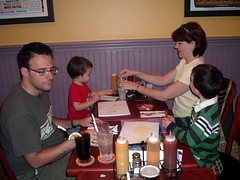
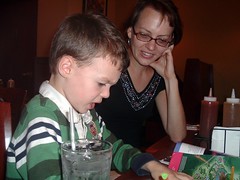
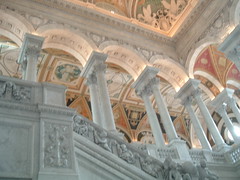

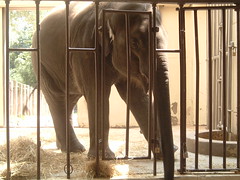
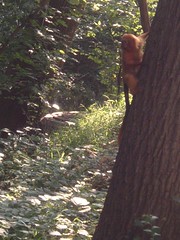
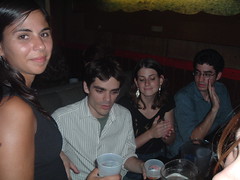
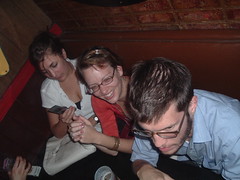
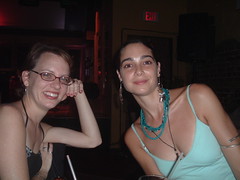
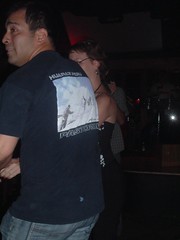
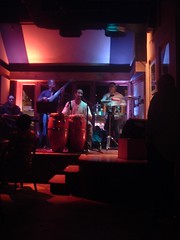
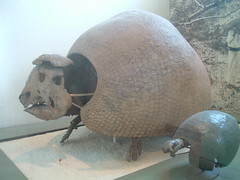
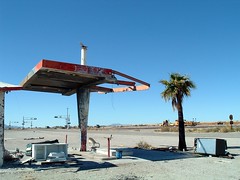
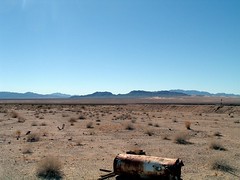
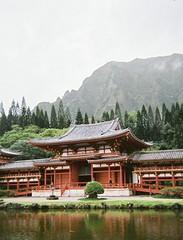 a beautiful Japanese temple in northeastern Oahu
a beautiful Japanese temple in northeastern Oahu